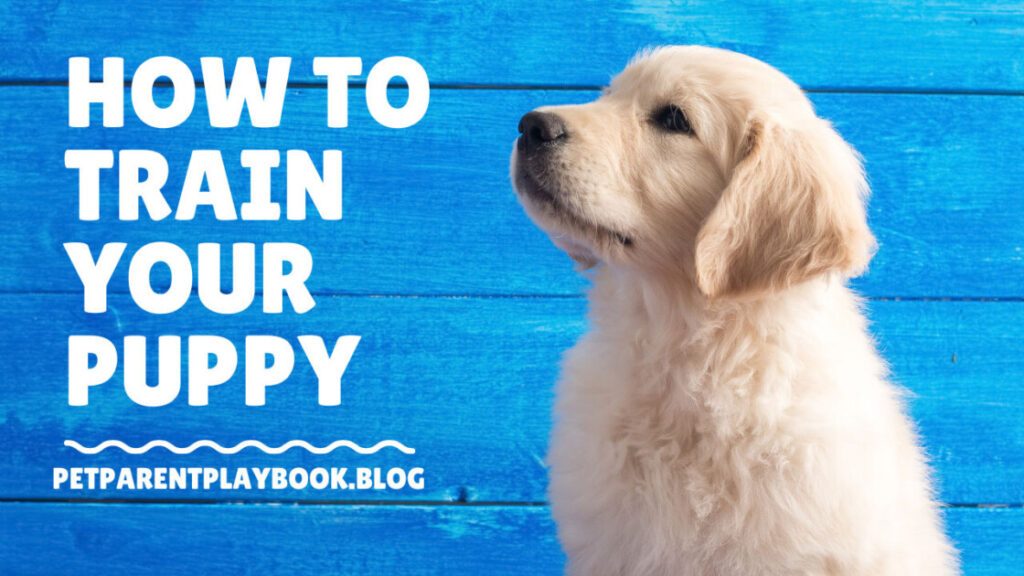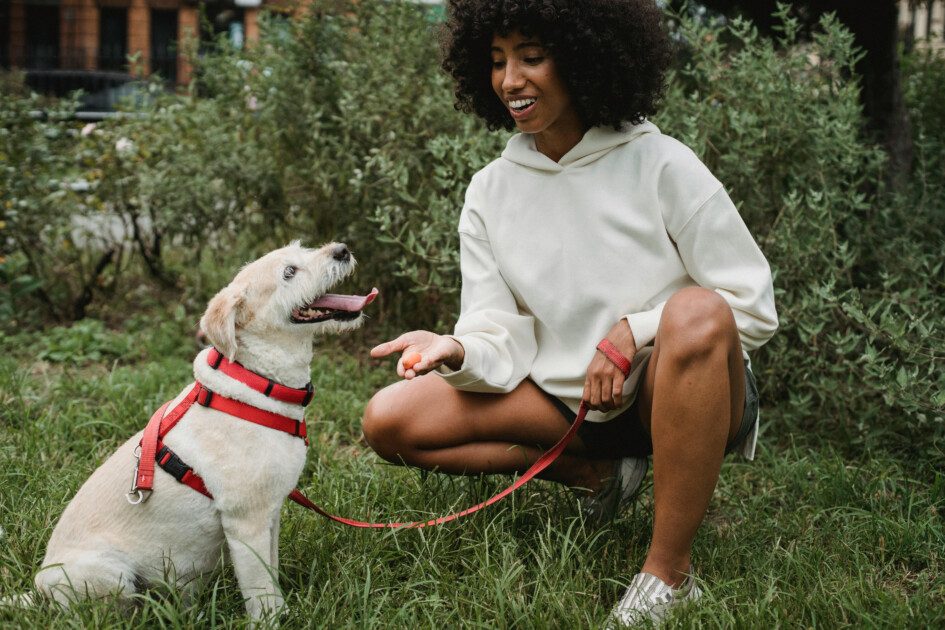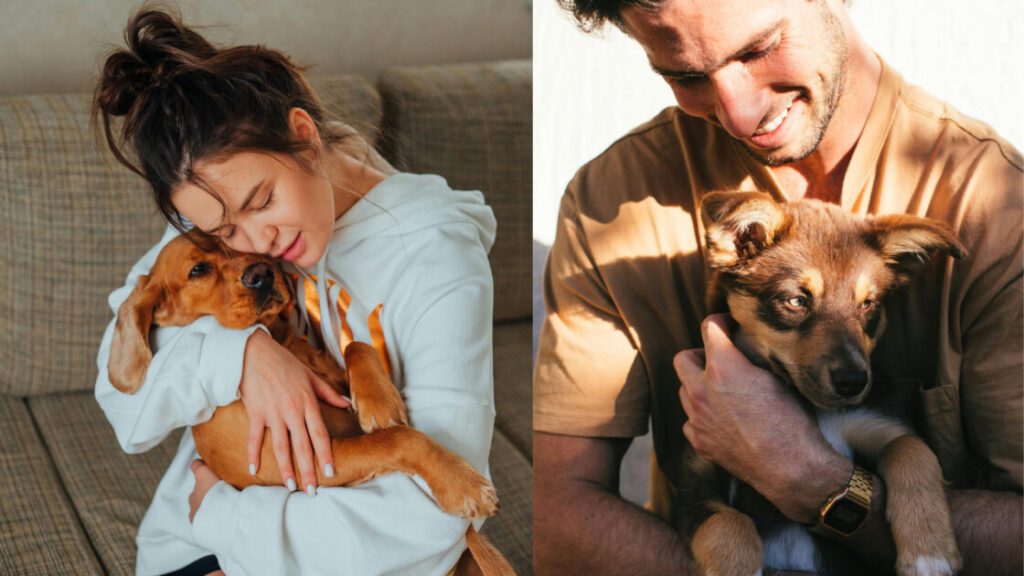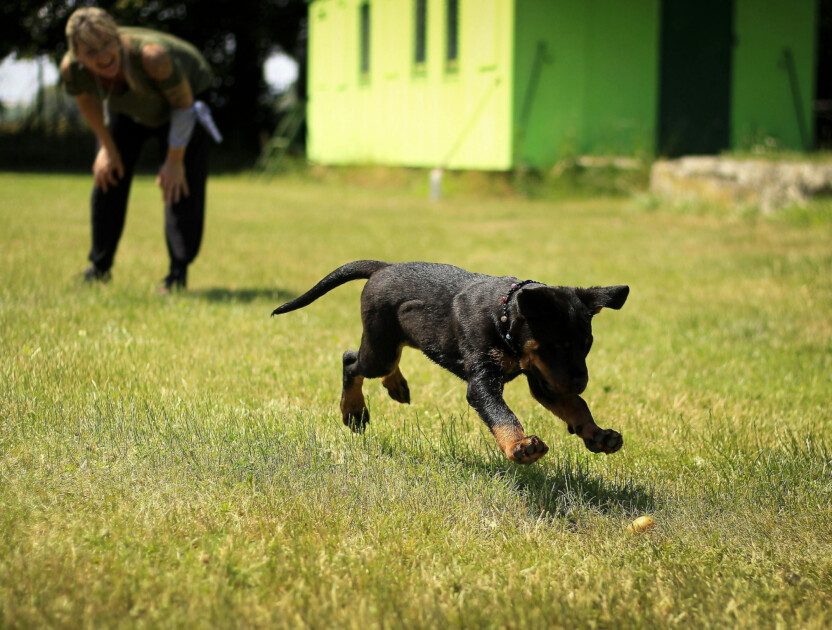Congratulations on welcoming a new furry friend into your life! Puppies are adorable bundles of joy, filled with boundless energy and enthusiasm. But let’s face it, that boundless enthusiasm can sometimes translate into unwanted behaviours like biting, leash pulling, or potty accidents. Fear not, new puppy parents! This comprehensive guide will equip you with the knowledge and techniques to effectively train your puppy, fostering a happy and well-behaved canine companion for years to come.

Here at the petparentplaybook blog, we understand that raising a puppy is a journey filled with both heartwarming moments and learning experiences. This guide will empower you with the tools you need to navigate puppyhood with confidence, building a strong foundation for a lifetime of love and respect with your furry friend.
Before diving into specific commands, let’s establish some essential principles that will guide your training approach:
The Power of Positive Reinforcement
Gone are the days of harsh corrections and dominance. Modern puppy training embraces the power of positive reinforcement. This means rewarding your puppy for good behaviour with treats, praise, or petting. When your puppy associates following your commands with positive experiences, they’re more likely to repeat the desired behaviour in the future.
Consistency is Key
Think of consistency as the magic ingredient in successful puppy training. Using the same cues, rewards, and corrections every single time is crucial. Repetition helps your puppy understand what you expect and builds trust in your training methods.
Short & Sweet Sessions
Puppies have short attention spans. Aim for frequent, short training sessions (5-10 minutes) throughout the day. This keeps your puppy engaged, prevents frustration, and makes the entire process more enjoyable for both of you.
Patience & Understanding
Accidents and mistakes are inevitable during puppyhood. Remember, your puppy is still learning about the world and how to interact appropriately. Be patient, offer gentle corrections, and redirect your pup to the desired behaviour. Punishments will only damage your relationship and hinder the learning process.
Now that we’ve established the foundation for positive and effective training, let’s explore some essential commands that will transform your chaotic walks into delightful strolls and your hectic home into a haven of happy co-existence.
Mastering the Essentials: Core Commands for a Well-Behaved Pup

1. Leash Walking: From Chaos to Calm Control
Leash walking can be a source of frustration for both you and your puppy. But with the right approach, you can transform those tangled leashes and frantic walks into enjoyable outings.
- Get the Right Gear: Start by ensuring you have the right equipment for comfortable and controlled walks. Choose a well-fitting harness that distributes pressure evenly across your puppy’s chest and back. A harness is a much more comfortable and humane option compared to a collar, especially for puppies whose necks are still developing. Complement the harness with a leash of appropriate length for the level of control you desire.
- Introduce the Leash & Harness: Don’t expect your puppy to embrace the leash and harness immediately. Let them get comfortable with the feel of the equipment by allowing them to wear it around the house for short periods. Reward them with treats or praise for calmly walking around while wearing the harness and leash. This positive association with the equipment will make future training sessions smoother.
- Start Indoors: Before venturing outside, practice leash walking in a quiet area inside your home. Hold the leash slack and lure your puppy to walk beside you with treats. The key here is to reward them for walking at your heel, not pulling ahead. Gradually increase the distance you walk as your puppy becomes comfortable with the concept.
- The Power of “Heel”: Once your puppy can walk comfortably beside you on a loose leash indoors, it’s time to introduce the “heel” command. With the leash in your hand, lure your puppy close to your leg with a treat. As they position themselves next to you, say “heel” in a clear and confident voice, and then reward them with the treat. Practice stopping and starting, gradually increasing the duration your puppy stays in the “heel” position.
2. Banishing Biting: Teething Troubles and Beyond
Puppies explore the world with their mouths, and nipping or biting can be a common behaviour, especially during teething when their gums are sore and itchy. While this might seem like harmless play to them, it can be painful for you. Here’s how to gently discourage biting:
- Teething Troubles: Understand that teething is a natural part of puppy development. Puppies experience discomfort and use their mouths to explore and soothe their gums. Provide a variety of chew toys made from safe materials like rubber or nylon to satisfy their chewing needs. Choose toys with interesting textures and shapes to keep your puppy engaged. Consider freezing wet washcloths or commercially available teething toys to provide a cooling sensation that can soothe their gums.
- Redirect & Replace: When your puppy starts nipping at your hands or clothes, immediately redirect them to a chew toy with a firm “no” and praise them for chewing on the appropriate object. This teaches them what is acceptable to chew on and what is off-limits.
- Ouch Training (Optional): This technique simulates a littermate’s reaction. When your puppy bites you, help or make a startled sound (high-pitched and short). This sudden change in your tone and demeanour discourages them from biting harder. Important Note: Do not use this method harshly or engage in rough play, as this can escalate the biting behaviour.
3. The Art of Staying: Building Focus and Patience
The “stay” command is a lifesaver for any dog owner. It helps control your puppy in various situations, preventing them from darting into traffic, chasing after squirrels, or jumping on unsuspecting guests.
- Start Small: Begin training in a quiet, controlled environment with minimal distractions. With your puppy on a leash in this area, hold a treat in front of their nose and slowly move it back over their head. As they remain seated, say “stay” in a clear and confident voice, and then reward them with the treat immediately.
- Gradually Increase Duration: Once your puppy can stay for a few seconds without breaking their seat, gradually increase the time you wait before rewarding them. Start with small increments of a few seconds and slowly build the duration as your puppy masters each step.
- Add Distance: Once your puppy can stay reliable for a short duration, practice staying a few steps back. Take a small step back, hold your hand up with a palm facing your puppy (a common “stop” signal), and say “Stay”. If they remain seated, return to them and reward them with the treat and praise. Gradually increase the distance as your puppy becomes comfortable with this variation.
4. The Rewarding Recall: Coming When Called
A reliable recall is a crucial safety measure for any dog owner. It allows you to call your puppy back to you, no matter how enticing the distraction might be.
- Make Coming to You Fun: The key to a successful recall is making it a positive experience for your puppy. Use a cheerful voice and praise them lavishly when they come to you, even if it’s just from across the room. This creates a positive association with the “come” command.
- Start Indoors: Begin training in a controlled environment like your living room. Drag a high-value treat (like cooked chicken or a piece of hot dog) on the ground, enticing your puppy to follow you. Once they reach you, say “come” in a happy voice, and reward them with the treat and enthusiastic praise.
- Practice with Distractions: Gradually introduce distractions like toys or family members. Reward your puppy for coming to you even with distractions present. This teaches them that coming to you is always the best option, regardless of the situation.
- Long Leash Practice: Move to a safe outdoor area with a long leash. Call your puppy’s name in a happy voice, then reward them with a treat and praise when they return to you. Gradually decrease the length of the leash as your puppy’s recall becomes more reliable.
Beyond the Basics: Essential Skills for a Happy Canine Companion
While mastering the core commands lays a strong foundation, here are some additional skills that will enhance your relationship with your furry friend and make a life together smoother:

1. Potty Training Essentials: Establishing Cleanliness
Potty training is a crucial aspect of puppyhood. Here’s how to guide your pup towards appropriate elimination habits:
- Establish a Routine: Take your puppy outside frequently, especially after meals, playtime, and waking up. Consistency is key to establishing a predictable bathroom schedule.
- Choose a Potty Spot: Designate a specific area in your yard as the potty zone. Take your puppy to this spot each time you take them outside. This helps them associate this location with elimination.
- Reward & Praise: When your puppy eliminates in the designated spot, shower them with praise and treats. This reinforces the desired behaviour and makes them more likely to repeat it in the future.
- Confine and Supervise: Confine them to a crate or puppy playpen to prevent accidents. The size of the crate should be large enough for them to stand up, turn around, and lie down comfortably, but not so big that they can be eliminated in one corner and still sleep in another. This utilizes their natural denning instinct and discourages elimination in their confined space.
- Be Patient & Consistent: Accidents happen, especially during the early stages of potty training. Be patient, clean up accidents with an enzyme cleaner that neutralizes odours, and redirect your puppy to the potty spot. Never punish your puppy for accidents, as this can create fear and anxiety around elimination.
2. Crate Training: Creating a Safe Haven
Crate training offers numerous benefits. It provides your puppy with a safe and secure space to relax, prevents separation anxiety, and aids in potty training. Here’s how to introduce your puppy to their crate:
- Make it Inviting: Turn the crate into a positive space by placing comfortable bedding inside, like a soft blanket or a crate pad. Offer chew toys or food-dispensing toys to keep your puppy occupied and happy while confined.
- Positive Crate Training Sessions: Start with short crate training sessions. Leave the door open and entice your puppy to enter with treats or praise. Reward them for calmly staying inside for short periods. Gradually increase the duration of these sessions as your puppy becomes comfortable.
- Never Use the Crate as Punishment: The crate should be a positive space for your puppy, not a place of confinement for bad behaviour. Avoid using the crate as punishment, as this can create negative associations.
3. Socialization: Building Confidence in a Diverse World
Socialization is the process of exposing your puppy to different people, animals, and environments in a controlled way. This helps prevent fear and anxiety later in life and fosters a well-rounded, confident canine companion.
- Puppy Playdates: Schedule playdates with other well-socialized puppies to allow your puppy to interact with their own kind. Supervise these interactions closely and ensure all playmates are up-to-date on vaccinations.
- Exposure to New Experiences: Take your puppy on outings to different locations, like parks, pet stores, or outdoor cafes (where allowed). This exposes them to new sights, sounds, and smells, helping them become comfortable in various environments.
- Positive Encounters with People: Encourage positive interactions with people of all ages, genders, and ethnicities. Ask friends and family to approach your puppy calmly, offering treats or petting them gently. This helps your puppy develop trust in unfamiliar people.
4. Teething Relief: Providing Safe Alternatives
Puppies experience discomfort and pain during teething. Here’s how to provide relief and prevent them from chewing on inappropriate objects:

- A Variety of Chew Toys: Offer a variety of chew toys made from safe materials like rubber or nylon. Choose toys with interesting textures and shapes to keep your puppy engaged. Consider freezing wet washcloths or commercially available teething toys to provide a cooling sensation that can soothe their gums.
- Rotate Toys Regularly: Freshness is key! Rotate your puppy’s chew toy selection regularly to keep them interested. This prevents them from becoming bored and seeking out other objects to chew on.
- Supervise Playtime: Closely supervise your puppy during playtime, especially when they’re teething. Redirect them to appropriate chew toys if they start chewing on furniture or other belongings.
Building a Bond of Trust and Respect
Puppy training is more than just teaching commands. It’s about building a strong foundation of trust and respect between you and your furry friend. Here are some additional tips to keep in mind:
- End on a Positive Note: Always finish training sessions on a successful note. This leaves your puppy wanting more and reinforces positive behaviour.
- Celebrate the Successes: Take the time to celebrate your puppy’s successes, no matter how small. A big “good job” or a high-value treat can go a long way in motivating them to keep learning.
- Seek Help When Needed: Don’t be afraid to consult a professional dog trainer if you encounter challenges. They can provide personalized guidance and support, addressing specific behavioural issues and helping you navigate the complexities of puppyhood.
Conclusion: A Rewarding Journey
With patience, dedication, and positive reinforcement, you can successfully train your puppy into a well-behaved and cherished companion. Remember, the journey of puppy training is a rewarding experience that strengthens the bond between you and your furry friend.
Also Read –
Bravecto for Dogs: A Comprehensive Guide for Responsible Pet Parents
The Royal Treatment: A Guide to Royal Canin Dog Food (Wet, Dry & More!)
Snuggle Up and Save: The Ultimate Guide to Dog Beds on Sale (Especially for Large Breeds!)
Essential Resources for Your Puppy Training Journey
Here are some valuable resources for your puppy training adventure:
Organizations:
- American Kennel Club (AKC):https://www.akc.org/
- The AKC offers a wealth of resources on puppy training, including articles, videos, and online courses. They also provide information on finding a reputable dog trainer in your area.
- Association of Professional Dog Trainers (APDT):https://apdt.com/
- The APDT website allows you to search for certified professional dog trainers (CPDTs) in your area. CPDTs have undergone rigorous training and adhere to ethical training practices.
- The Humane Society of the United States (HSUS):https://www.humanesociety.org/
- The HSUS provides information on humane dog training methods, including positive reinforcement techniques. They also offer resources on responsible pet ownership and puppy socialization.
Books:
- “Don’t Shoot the Dog!” by Karen Pryor: https://www.amazon.com/Dont-Shoot-Dog-Teaching-Training/dp/1860542387
A classic text on positive reinforcement training methods, offering clear explanations and practical application tips. - “The Power of Positive Dog Training” by Pat Miller: https://www.amazon.com/Power-Positive-Dog-Training/dp/0470241845 Another excellent resource on positive reinforcement, emphasizing building a strong bond with your furry friend through positive training techniques.
- “Puppy Diaries” by Patricia B. McConnell: https://www.amazon.com/Puppy-Diaries-Raising-Named-Scout/dp/B007PLZYJO A charming and informative book that chronicles the author’s experience raising a puppy, offering insights into puppy development and behavior.
Websites & Online Courses:
- Zak George’s Dog Training YouTube Channel: https://www.youtube.com/channel/UCZzFRKsgVMhGTxffpzgTJlQ Zak George, a renowned dog trainer, offers a plethora of free video tutorials on various dog training topics using positive reinforcement methods.
- Karen Pryor Clicker Training: http://www.clickertraining.com/ Karen Pryor’s website offers information on clicker training, a positive reinforcement technique that uses a clicker to mark desired behaviors. Clicker training resources and online courses are available on the site.
- The Puppy Training Institute: https://www.puppytrainingusa.com/
The Puppy Training Institute offers online courses on various aspects of puppy training, taught by professional dog trainers.
Additional Resources:
- Social Media Groups: Consider joining Facebook groups or online forums dedicated to puppy training. These platforms allow you to connect with other dog owners, share experiences, and ask questions.
- Veterinarian: Your veterinarian can be a valuable resource for puppy training advice and ensuring your pup’s overall health and well-being.
Remember, the key to successful puppy training is to choose resources that align with positive reinforcement methods and prioritize humane and effective training practices. Happy training!
Puppy Training FAQ: Essential Answers for New Dog Owners
Q: At what age should I start training my puppy?
A: You can start training your puppy as early as 8-9 weeks old. The sooner you begin, the easier it will be for them to learn and develop good habits.
Q: How long do puppy training sessions need to be?
A: Aim for short and frequent training sessions (5-10 minutes) throughout the day. Puppies have short attention spans, so keep it engaging and positive.
Q: What is the best reward to use for training?
A: High-value treats like cooked chicken, hot dogs, or small pieces of cheese can be great motivators. Praise and petting can also be effective rewards.
Q: My puppy pulls on the leash during walks. What can I do?
A: Use a well-fitting harness and practice leash walking indoors first. Lure your puppy to walk beside you with treats and gradually increase the distance as they learn the “heel” command.
Q: My puppy nips and bites. How can I stop this behaviour?
A: Provide a variety of safe chew toys and redirect your puppy to them when they start nipping. The “ouch” training technique (a startled sound) can also be helpful, but avoid using harsh corrections.
Q: How can I potty train my puppy?
A: Establish a consistent routine, taking your puppy outside frequently after meals, playtime, and waking up. Choose a designated potty spot and reward them for eliminating there. Confine them to a crate or puppy playpen when you can’t supervise them to prevent accidents.
Q: What if my puppy is crying in their crate?
A: Make sure the crate is the right size and provide comfortable bedding. Gradually increase the duration of crate time and never use it as punishment.
Q: I’m feeling overwhelmed with puppy training. What should I do?
A: Don’t hesitate to seek help from a professional dog trainer. They can provide personalized guidance and support for specific challenges you might be facing.
Q: Where can I find more resources on puppy training?
A: Consider exploring websites, books, or online videos offering additional puppy training tips and techniques. Look for resources that emphasize positive reinforcement methods.
Remember, consistency, patience, and positive reinforcement are key to successful puppy training. Feel free to leave any additional questions you might have in the comments below!